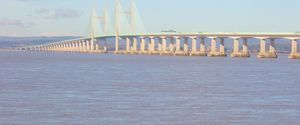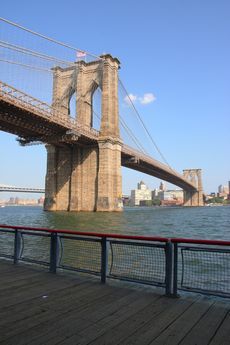Suspension Bridge - From Earliest to Modern Designs
Suspension bridge is a type of bridge which has cables between towers (so called “suspension cables”) and from them vertical “suspender cables” (or hangers”) that hold the deck. Suspension cables are anchored at each end of the bridge and they carry the majority of the load.
Suspension bridges, as we know them today and of which the first modern examples were built in the early 19th century, actually evolved from the “simple suspension bridges”. These bridges are one of the oldest types made by man. They have load-bearing cables but don’t have towers.
Earliest versions of suspension bridges were built by Thangtong Gyalpo, Tibetan saint and bridge-builder (among other things) from the 15th century. He built over 58 iron chain suspension bridges around Tibet and Bhutan and one of his bridges survived until 2004 when it was destroyed by a flood. Most of his bridges had chains as suspension cables while his early bridges used ropes from twisted willows or yak skins.

The first design of a suspension bridge that is similar to today's modern designs appeared in book “Machinae Novae” from 1959 which was written by Venetian polymath Fausto Veranzio. He also has designs in his book for a timber and rope suspension bridge, and a hybrid suspension and cable-stayed bridge using iron chains.
The first iron chain suspension bridge on the soil of United States was one made at Jacob's Creek in Westmoreland County, Pennsylvania in 1801. This bridge was the first to have all the necessary components of a modern suspension bridge and was designed by James Finley who patented a system for suspending a rigid deck from a bridge's cables in 1808. This years is considered as a begging o the era of the modern suspension bridges. After that, two bridges were built in England: Dryburgh Abbey Bridge (built in 1817) and Union Bridge (built in 1820). The first large bridge that used the technique invented by Finley was bridge over the Menai Straits in Wales built by Thomas Telford and finished in 1826. Cables consisting of many strands of wire for suspension were used instead of chains for the first time in 1930 by French engineers. Soon John Roebling, American inventor, found a way to spin the cables at the place of building instead of transporting them prefabricated. He also invented rigid deck platform which is stiffened with trusses.
Since then suspension bridges became popular because they allowed to bridge spaces that could not be bridged with conventional methods. Its advantages are that it can be made with longer spans than with other types; it is cheaper bridge type (even with longer spans) because it uses less material; during construction it does not require access from below so it doesn't matter much what is below nor how high is bridge; it is more earthquake-proof than other types; and it can be modified easily to accommodate wider vehicles or to add additional lanes. Like everything it also has its disadvantages: it must be made very stiff or aerodynamic so high winds wouldn't cause vibrations; and it is very difficult for to carry heavy rail traffic compared to other bridge types because of relatively lower stiffness of a board.

When compared, suspension bridges are often compared by the length of their main span (longest span they have). Akashi Kaikyō Bridge is the suspension bridge with the longest span in the world since 1998. Its main span has 1,991 meters in length and it connects Kobe and Awaji Island in Japan. Second longest mains pan has Xihoumen Bridge on the Zhoushan Archipelago, the largest offshore island group in China with 1,650 meters.


